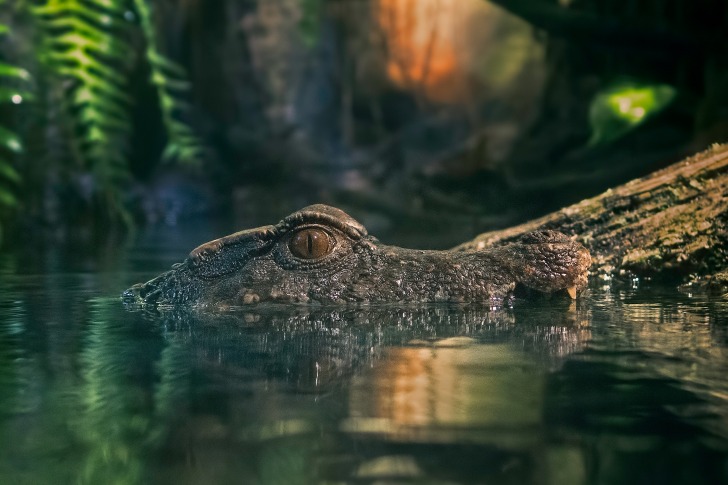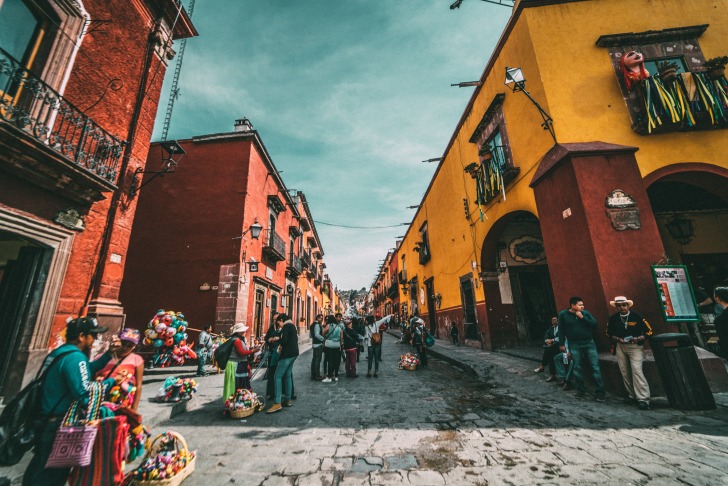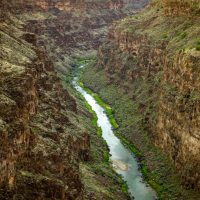Have you ever wondered if there are alligators in Mexico?
After all, the country shares a border with Texas, a state known to be home to many American alligators.
There are two species of alligator: the American alligator (A. mississippiensis) and the Chinese alligator (A. sinensis).
All other species of alligators have gone extinct.
According to the United States Geological Survey, the native habitat of the American alligator is from coastal North Carolina to the Southeastern United States and westward to central Texas and the deep south.
Furthermore, there is a likelihood that alligators may be found in some regions of the border between Mexico and Texas.

Contents
So… Are There Alligators in Mexico
The answer to this question is yes and no.
Alligators are not native to Mexico.
Crocodiles, on the other hand, are native to Mexico.
The Morelet crocodile (Crocodylus moreletii), also commonly known by two other names: the Mexican crocodile or the Belize crocodile, can be found in many regions of Mexico.
There have been many sightings of crocodiles in Mexico that have been mistaken for alligators.
But for the most part, these are not alligators.
They are, in fact, crocodiles.
Traditionally, crocodiles live in saltwater or brackish water.
However, the Morelet crocodile lives in the Atlantic region of Mexico in freshwater environments.
This map highlights the location of these crocodiles as well as the location of any alligators that are present in Mexico.
The crocodiles, as evident from the map, are highlighted in purple and can be found, as previously indicated, along the Atlantic coast of Mexico and most of the Mexican coastline.
The map further highlights the presence of the American alligator.
From the map, it’s clear that the USGS’s sentiments regarding the American alligator’s migration to some parts of Mexico from the Texas/Mexican border were accurate.
Texas and Mexico share 1,254 miles of the border.
However, the alligators seem to be migrating south on the eastern side of the borderline.
It has to be mentioned that alligators are reptiles and are not known to migrate.
But, according to the map, it’s clear that the American alligator has moved from Texas down to Mexico.
The American alligator is highlighted in orange, and there is a clear presence in the Gulf Coast Prairies and the Marshes of Mexico.
These alligators seem to have migrated from the northern Texan border into Mexico.
As per the map, the alligators are only found in this specific region of Mexico.
However, with time, these alligators may migrate south into Mexico.
The area is described as tropical and subtropical savannahs, shrublands, and grasslands.
Alligators thrive in warmer climates, which means that Mexico has the ideal climate to host gators.
Alligators are ectothermic and rely on external heat sources to maintain their body temperature.
They are usually found in climates where the weather is around 82°F to 92°F.
Alligator Species in Mexico
The alligator species found in the Gulf Coast Prairies and the Marshes of Mexico are American alligators (Alligator mississippiensis).
These alligators are colloquially referred to as gators.
They are large crocodilian reptiles.
The American alligator is traditionally native to the Southeastern United States.
They can grow to between 11 and 16 feet in length and up to 1,250 pounds.
The female of the species is generally smaller than the male.
They are traditionally found in tropical and sub-tropical freshwater wetlands.
Is it Safe to Swim in Mexico?
The alligators found in Mexico are mostly found in the Gulf Coast Prairies and the Marshes.
These are not places where people traditionally swim.
However, it would probably not be a good idea if someone were to consider swimming in these wetlands.
Herbaceous plants dominate wetlands.
These types of plants can make it difficult to spot any alligators that may be hiding in the marshland.
Apart from the obvious threat from alligators who may be waiting for their next meal are a host of other dangerous animals and species that call this area home.
These include black bears, snakes, and crocodiles as well.
The next obvious question would relate to the beaches and lakes found in Mexico and whether or not they are safe to swim in.
According to one crocodile expert and biologist on Reddit, there are three species of crocodile are prevalent in Mexico: the American crocodile (Crocodylus acutus), the spectacled caiman (Caiman crocodiles), and the Morelet’s crocodile (C. moreletii).
It is further reported that the Rio Grande American alligator (Alligator mississippiensis) has been spotted at various locations around Mexico.
However, we are sure they are predominantly found in the Gulf Coast Prairies and the Marshes, and many of these sightings are crocodiles.
It is further highlighted that crocodiles are found at many tourist destinations in Mexico’s coastal regions.
It may be best to avoid these areas and avoid swimming in them.
However, it’s clear that tourists are not too bothered and do the swim on the beaches and coastal regions of Mexico.
Furthermore, several popular beaches in Mexico have been declared unsafe for swimming because dangerous levels of bacteria were found in the water.
In addition, there were news reports that indicated some beaches were not safe to swim in because of the dangerous levels of contamination in the water on these beaches.
There are many other reasons to avoid swimming in the ocean in Mexico, including sea lice, barracuda, strong currents, and the threat of drowning.
Many tourists travel to Mexico yearly, and many do not experience any dangers.
If you follow any health advisory reports and practice reasonable caution, there should be no problem.
Always avoid any swimming area known to be home to alligators or crocodiles.
Interesting Alligator Facts in Mexico
American alligators are often found in groups.
If you are wandering on the Gulf Coast of Mexico and stumble upon an alligator, several more are nearby.
Alligators take turns hunting and surveying their surroundings.
They also work together to protect their offspring.
They are opportunistic hunters and will go for months or even years without eating.
It’s imperative to remain vigilant in areas where you know alligators have been spotted or live.
Because these alligators will wait just out of sight until their prey is close enough before they attack, the American alligator can sprint at 35 miles per hour.
But, they quickly get tired and stop.
If an alligator ever chases you, your best bet is to run straight ahead as fast as you can.
The American alligator builds nests before laying its eggs.
These nests are made up of vegetation and are meant to keep the eggs safe and warm, and nests can be up to 10 feet in size.
The alligator nests usually contain clutches of 35 to 50 eggs, but it’s not unusual for a clutch to contain up to 90 eggs.
The temperature of the eggs will determine the sex of the offspring.
Cooler temperatures produce females, and warmer temperatures produce males.
Alligators can communicate with each other through a series of sounds.
Alligators are hunted for their skin and meat in parts of the United States.

Alligators vs. Crocodiles
There are three types of crocodiles found in Mexico:
- The American crocodile (Crocodylus acutus)
- The spectacled caiman (Caiman crocodiles)
- The Morelet’s crocodile (C. moreletii)
Only one species of alligator is found in Mexico: the Rio Grande American alligator (Alligator mississippiensis).
So what are the key differences between these alligators?
Crocodiles prefer freshwater and saltwater environments, while alligators only prefer freshwater environments.
The snout of crocodiles is longer and is shaped like a V, while the snout of the American alligator is more rounded and shaped like a U.
This is a very distinct difference between these two types of reptiles.
Crocodiles are typically regarded as more aggressive and dangerous to humans than alligators, who are considered more opportunistic and less dangerous.
The upper and lower jaw of the crocodile is the same size, and when they close their jaw, you can see both sets of teeth.
However, an alligator has a larger upper jaw, and you can only see its upper teeth when it closes its mouth.
There are 15 different species of crocodiles and only 8 different species of alligators.
Crocodiles are slower than alligators, who can travel fast on land and in water.
Alligators are known to sprint up to speeds of 35 miles per hour, albeit for a short distance only.
3 Safety Tips for Swiming in Alligator-infested Waters
- Avoid swimming in alligator-infested water. The first and most obvious tip is to avoid swimming in water that has alligators in it. It is better to be safe than sorry. Alligators may be unpredictable at times. Though an alligator attack is rarer than it is common, it is better not to take any chances.
- Never splash the water where alligators are known to live or swim. When you splash the water, the alligator may see this as a sign of a food source and may attack. Remember that alligators are opportunistic hunters who will lay and wait for a food source to come close before attacking.
- Don’t allow animals or young children near water edges where alligators are present. An alligator cannot tell the difference between your pet and its food source. It may attack unprovoked.
Summary
Alligators are not native to Mexico, but there have been sightings in the Gulf Coast prairies and marshes.
These are commonly American alligators that have made their way from the Texas border down south.
While alligators are not known to be aggressive and won’t readily attack unprovoked, there have been reports of opportunistic attacks on people.
If you plan to visit Mexico and do some sightseeing, research the area you will be visiting to see what kind of dangers you may expect when traveling to that destination, and practice reasonable caution.
Prevention is always better than cure.
Alligators are not the main concern when traveling to Mexico; crocodiles are.
Crocodiles are found along the country’s coastal region and in many tourist attractions.
They are known to be more aggressive and dangerous to humans than alligators.
Where ever you travel, always practice reasonable caution.
Mexico Safety Overview
READ THE FULL REPORT: Mexico Safety Review
Safety Index:
- OVERALL RISK: MEDIUM
- TRANSPORT & TAXIS RISK: LOW
- PICKPOCKETS RISK: HIGH
- NATURAL DISASTERS RISK: LOW
- MUGGING RISK: MEDIUM
- TERRORISM RISK: LOW
- SCAMS RISK: HIGH
- WOMEN TRAVELERS RISK: LOW
Frequently Asked Questions
Have there been any reports of alligator attacks in Mexico?
No, there have been no documented reports of alligator attacks in Mexico.
There are probably several reports of crocodile attacks in the country, as crocodiles are more native to Mexico.
Can you swim with saltwater crocodiles?
No.
It is far too dangerous.
Do you get saltwater crocodiles in Mexico?
Yes.
Saltwater crocodiles can be found on the Caribbean coast of Mexico.












Yes, there are alligators in Mexico, but they are not native to the country, and it’s rare to spot one.
It’s always best to avoid these areas and swim in safer waters when traveling to Mexico.